
HMS Badger was an Acheron-class destroyer of the Royal Navy that served during the First World War and was sold for breaking in 1921. She was the eighth Royal Navy ship to be named Badger, after the mammal of the same name.
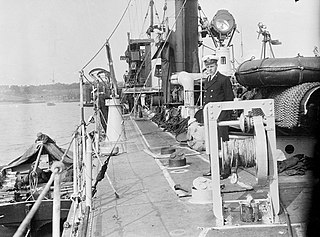
HMS Laforey was the lead ship of her class of destroyer built for the Royal Navy. Launched a year before the First World War began, she was attached to the Dover Patrol. Laforey saw action in several engagements with German torpedo boats, including the Battle off Noordhinder Bank and the action of 17 March 1917. Laforey was sunk in 1917 by a British mine after escorting several freighters to France. She was named for Francis Laforey, captain of HMS Spartiate at the Battle of Trafalgar in 1805.

HMS Opal was an Admiralty M-class destroyer of the Royal Navy. She served in the First World War following her construction at Sunderland in 1915. Attached to the 12th Destroyer Flotilla based with the Grand Fleet at Scapa Flow, Opal had an eventful short life, which ended in shipwreck after two and a half years of service.

HMS Hydra was one of 20 Acheron-class destroyers built for the Royal Navy in the 1910s. Completed in 1912, the ship participated in World War I and was sold for scrap in 1921.

HMS Lizard was an Acheron-class destroyer of the British Royal Navy. She is named for the Lizard peninsula in the county of Cornwall in England. and was the twelfth ship of the Royal Navy to bear the name.
HMS Faulknor was a British destroyer of the First World War. She was purchased by the Royal Navy whilst still under construction in Britain for the Chilean Navy who had ordered her in 1912 as part of the Almirante Lynch class. She was renamed after the Faulknor family of British nineteenth century naval officers.

HMS Fearless was one of three Active-class scout cruisers built for the Royal Navy shortly before the First World War. Upon completion in 1913, the ship was assigned to the 1st Light Cruiser Squadron (LCS) of the 1st Fleet. She became flotilla leader of the 1st Destroyer Flotilla (DF) shortly before the start of the war in August 1914 and was transferred to the Harwich Force shortly after it began. Fearless participated in the Battle of Heligoland Bight and the Cuxhaven Raid later that year. The ship was transferred to the Grand Fleet in early 1915 and played a minor role in the Battle of Jutland the following year.

HMS Defender was an Acheron-class destroyer which was built in 1911, served throughout World War I and was broken up in 1921. She was the fifth ship of the name to serve in the Royal Navy.

HMS Acheron was the name ship of the Acheron-class destroyer of the British Royal Navy. She is named after the River Acheron, believed in Greek Mythology to be a branch of the River Styx. She was the fifth ship of the Royal Navy to bear the name.
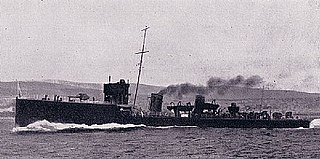
HMS Lurcher was a modified Acheron-class destroyer, named after the lurcher-type dog, and the fifth ship of the Royal Navy to bear the name; when new she was the fastest ship in the Royal Navy.
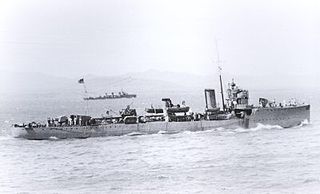
HMS Phoenix was an Acheron-class destroyer of the British Royal Navy. She is named for the mythical bird, and was the fifteenth ship of the Royal Navy to bear the name. She was the only British warship ever to be sunk by the Austro-Hungarian Navy.
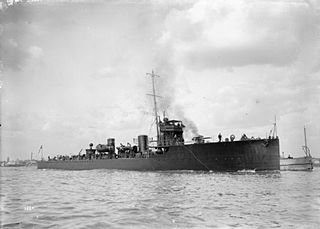
HMS Ariel was an Acheron-class destroyer built in 1911, which served during the First World War and sank in 1918 after striking a mine. Named after Shakespeare's "airy spirit", or the biblical spirit of the same name, she was the tenth and last ship of the name to serve in the Royal Navy.

The Action of 22 September 1914 was an attack by the German U-boat U-9 that took place during the First World War. Three obsolete Royal Navy cruisers, of the 7th Cruiser Squadron, manned mainly by Royal Naval Reserve part-time reservists and sometimes referred to as the Live Bait Squadron, were sunk by U-9 while patrolling the southern North Sea.

HMS Goshawk was an Acheron-class destroyer of the Royal Navy that served during World War I and was sold for breaking in 1921. She was the sixth Royal Navy ship to be named after the bird of prey, Accipiter gentilis.
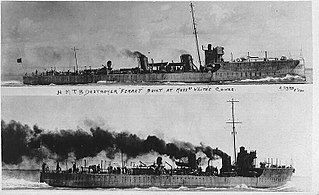
HMS Ferret was an Acheron-class destroyer of the Royal Navy that served during World War I and was sold for breaking in 1921. She was the sixteenth Royal Navy ship to be named after the domestic mammal Mustela putorius.

HMS Forester was an Acheron-class destroyer of the Royal Navy that served during World War I and was sold for breaking in 1921. She was the ninth Royal Navy ship to be named after the traditional craft of forester.
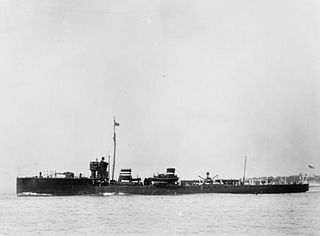
HMS Lapwing was an Acheron-class destroyer of the Royal Navy that served during World War I and was sold for breaking in 1921. She was the seventh Royal Navy ship to be named after Vanellus vanellus, the northern lapwing.
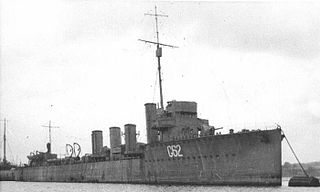
HMS Marksman was a Marksman-class flotilla leader of the British Royal Navy. Construction at Hawthorn Leslie's Newcastle upon Tyne shipyard began in 1914, shortly before the outbreak of the First World War, and the ship was launched and completed in 1915. She took part in the Battle of Jutland in 1916 and survived the war. She was sold for scrap in 1921.

HMS Landrail was a Laforey-class destroyer of the British Royal Navy. The Laforey class was the class of destroyers ordered under the Royal Navy's 1912–1913 construction programme, which were armed with three 4-inch (102 mm) guns and four torpedo tubes and were capable of 29 knots. The ship, which was originally to be named Hotspur but was renamed before launch, was built by the Scottish shipbuilder Yarrow between 1912 and 1914,

HMS Mindful was a Admiralty M-class destroyer which served with the Royal Navy during the First World War. The M class destroyers were an improvement on the previous L-class, capable of higher speed. The vessel, launched in 1915, joined the Twelfth Destroyer Flotilla under the flotilla leader Faulknor. The ship saw action during the Battle of Jutland in May 1916 and helped sink the German torpedo boat SMS V48. In March 1917, the destroyer was involved in a friendly fire incident, nearly sinking the British submarine G12. In June that year, the vessel was involved in the sinking of the German merchant ship SS Gamma in Norwegian waters, which led to a diplomatic protest from the Norwegian government. At the end of the war, Mindful was withdrawn from service and, in 1921, sold to be broken up.






















